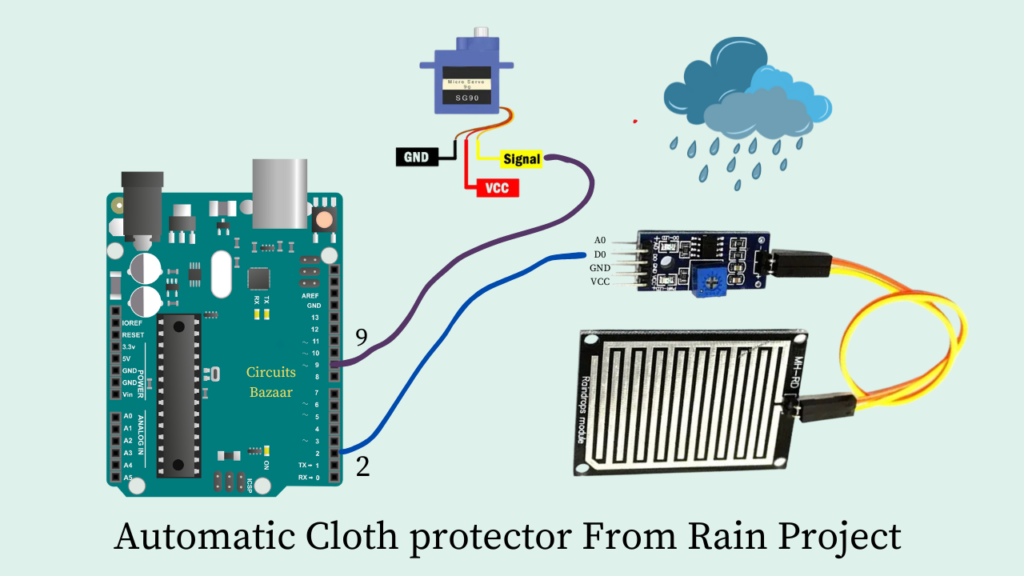Amazing Project Ideas
Automatic RainShield: Intelligent Rain-Activated Clothes Cover Project
Introduction
In the realm of innovative technology and smart solutions, the integration of electronics with everyday items is becoming increasingly prevalent. One such groundbreaking project is the “Automatic RainShield,” a weather-responsive clothes cover designed for college students. This project seamlessly combines Arduino Uno, a servo motor, a rain sensor, and some basic electronic components to create a hands-free rain protection system.
Why Automatic RainShield?
Living in regions with unpredictable weather can be challenging, especially for students commuting to college. The Automatic RainShield aims to provide a practical and intelligent solution to this problem. By utilizing the power of Arduino Uno and a rain sensor, this project ensures that students can effortlessly shield themselves from unexpected rain without the hassle of manually putting on rain gear.

Video Demonstration:
Download Data of the project:- Click Here
Want to Buy the Project Kit:- Click Here OR Contact at +91-8571964488 ( Call or Whatsapp )
Components Needed
Arduino Uno: The brain of the project, responsible for processing data from the rain sensor and controlling the servo motor.
Servo Motor: Mechanism for opening and closing the clothes cover.
Rain Sensor: Detects rain and triggers the servo motor to deploy the RainShield.
Wires and Connectors: Essential for establishing connections between components.
Power Source: Provides the necessary energy to run the Arduino Uno and servo motor. we can give power with usb port of laptop or adaptor Or we can also give power with 9v or 12v adaptor.
Building the Automatic RainShield
Step 1: Connect the Rain Sensor Start by connecting the rain sensor to the Arduino Uno. Ensure proper wiring and make sure the sensor is appropriately positioned to detect raindrops effectively.
Step 2: Connect the Servo Motor Establish a connection between the servo motor and the Arduino Uno. The servo motor will be responsible for the movement of the RainShield, deploying and retracting it as needed.
Step 3: Code the Arduino Uno Write a program for the Arduino Uno to process data from the rain sensor and control the servo motor. The code should include conditions for rain detection and servo motor movement.
Step 4: Assemble the RainShield Mechanism Create a simple and lightweight cover that can be easily deployed and retracted by the servo motor. Ensure that it provides sufficient coverage to protect the user from rain.
Step 5: Test the Automatic RainShield Run tests to ensure the rain sensor accurately detects rain, and the servo motor responds appropriately by deploying the RainShield. Make any necessary adjustments to the code or hardware.
Conclusion: The Automatic RainShield project is a testament to the intersection of technology and everyday convenience. College students can now navigate unpredictable weather conditions with ease, thanks to this intelligent rain-activated
Advantages:
Convenience: Offers hands-free rain protection for quick response in sudden downpours.
Hands-Free Operation: Allows users to focus on tasks without manually donning rain gear.
Quick Response: Rapid deployment upon rain detection provides immediate protection.
Customizable Design: Modular design allows users to adapt the RainShield to their style.
Educational Value: Enhances practical skills in electronics and programming for college students.
Disadvantages:
Power Dependency: Requires a power source, necessitating consideration of battery life and recharging.
Mechanical Complexity: Potential mechanical failures or wear and tear may require maintenance.
Limited Coverage: Design limitations may leave some body parts exposed to rain.
False Triggers: Sensitivity of rain sensor may lead to unnecessary deployment in non-rainy conditions.
Future Scope:
Smart Device Integration: Explore integration with smartphones for remote control and monitoring.
Enhanced Sensing Technology: Implement advanced sensing technologies for improved accuracy.
Energy Harvesting: Investigate energy harvesting techniques for sustainability.
Fashion Integration: Collaborate with designers for stylish and customizable RainShield designs.
IoT Connectivity: Implement IoT for data logging, monitoring, and community-driven weather data sharing.
